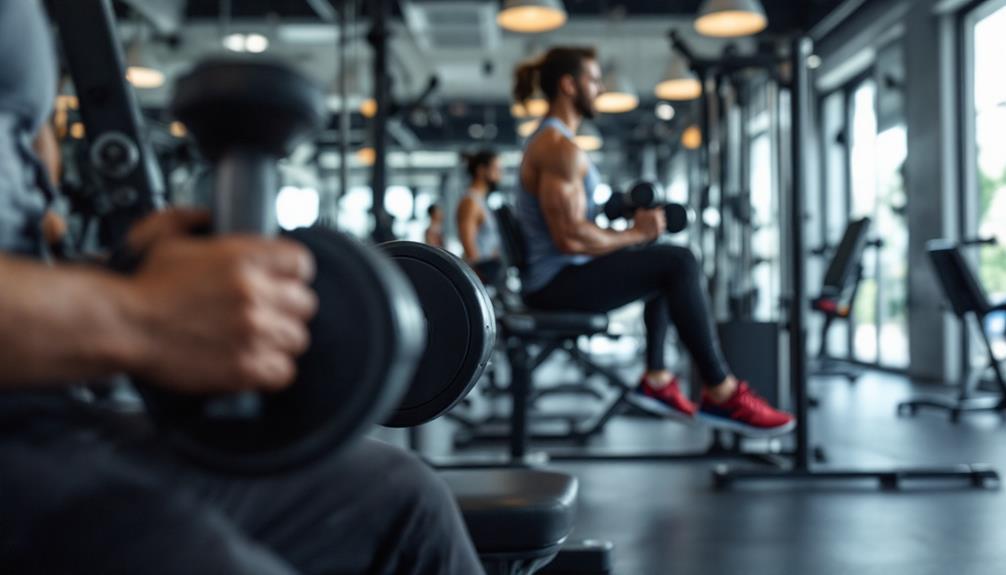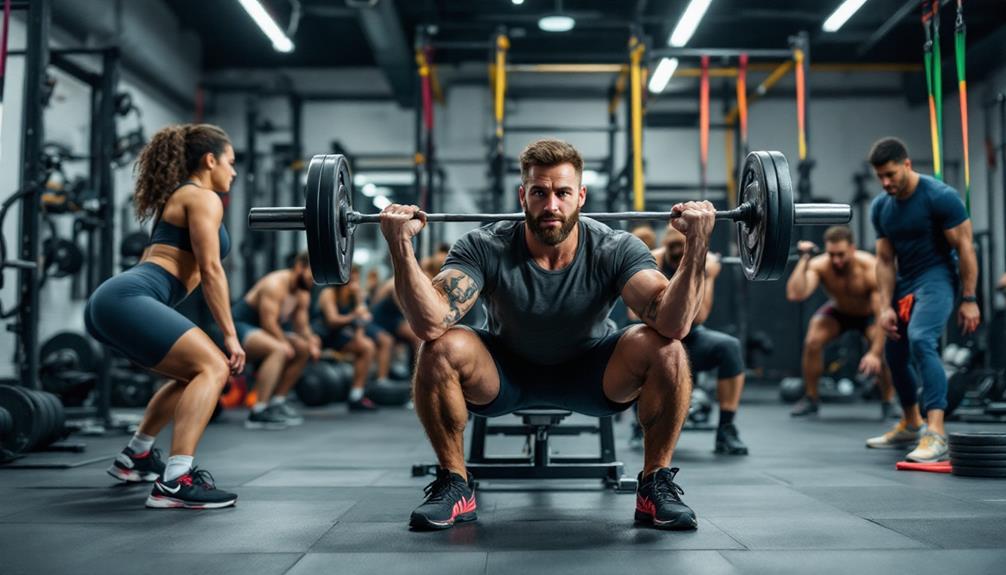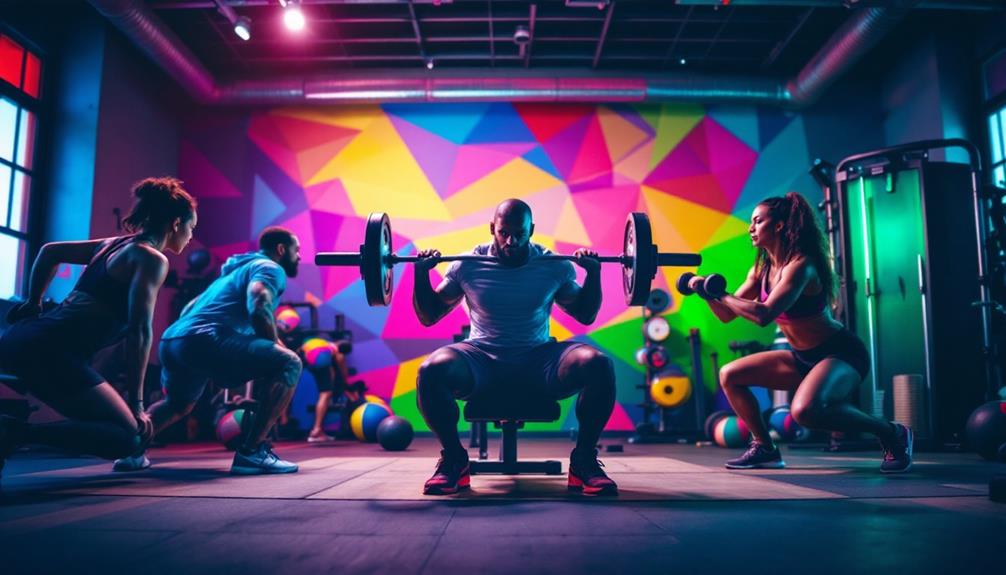Common strength-focused resistance training exercises include both compound and isolation movements. Compound exercises, like squats, deadlifts, and bench presses, engage multiple muscle groups and enhance functional strength. Isolation exercises, such as bicep curls and tricep extensions, focus on individual muscles, helping to balance strength and improve appearance. For the upper body, consider push-ups and dumbbell rows, while lunges and leg presses benefit the lower body. Don't forget core exercises like planks and Russian twists to enhance stability. Incorporating these options can provide all-encompassing strength training and performance improvements, so let's explore more effective techniques.
Core Insight
- Compound exercises like squats, deadlifts, and bench presses engage multiple muscle groups for effective strength building.
- Isolation exercises, such as bicep curls and tricep extensions, target specific muscles to enhance strength and definition.
- Upper body strength can be developed through push-ups, dumbbell rows, and overhead presses, focusing on form and gradual weight increases.
- Lower body movements like lunges and leg press target major muscle groups for improved strength and balance.
- Core exercises such as planks and Russian twists strengthen stability, enhancing overall performance in strength training.
Benefits of Resistance Training

Resistance training has many benefits that can improve your fitness and well-being. One major advantage is increased muscle strength. When you lift weights, your muscles get stronger and work better. This means you can perform daily activities more easily. To help with recovery after workouts, think about using muscle recovery supplements with BCAAs and other helpful ingredients to support your strength training.
Another benefit of resistance training is that it boosts your metabolism. Building muscle increases the number of calories you burn at rest, which can help with weight management.
Additionally, resistance training improves joint stability. Stronger muscles around your joints lower the risk of injuries.
Finally, it can enhance bone density, which is important as you age. Stronger bones can help prevent fractures.
Adding resistance training to your routine can significantly improve your fitness journey.
Compound Exercises Overview

Compound exercises are key for building strength effectively because they work several muscle groups and joints at the same time. By adding these exercises to your routine, you can get better results in less time. Here's why you should include them:
- Increased Efficiency: You engage more muscles with one movement.
- Better Functional Strength: These exercises reflect daily activities, helping improve your overall strength.
- Enhanced Hormonal Response: Compound exercises boost the release of growth hormones.
While traditional weightlifting is helpful, using resistance tubes can be a portable and flexible option for compound exercises. These tubes come in different resistance levels, making them suitable for various fitness goals, from toning to building strength.
Adding compound exercises like squats, deadlifts, and bench presses to your workouts can take your training to the next level. They help build raw power and also improve coordination and balance. As you continue, you'll see big improvements in both your strength and overall performance.
Isolation Exercises Explained

Isolation exercises are important for building strength and definition in specific muscles. Unlike compound exercises, which work multiple muscle groups at once, isolation exercises focus on one muscle at a time. This method allows you to strengthen weaker areas or shape specific muscles. When paired with natural muscle toners, isolation exercises can also improve your overall appearance and skin health. These toners often include ingredients like witch hazel and aloe vera, which can help maintain skin elasticity as you work on muscle definition.
Some common isolation exercises are bicep curls, tricep extensions, and leg curls. By focusing on one muscle, you can increase its strength and size, which helps maintain muscle balance.
Adding these exercises to your routine can lead to noticeable improvements in performance and appearance. To get the most out of them, focus on controlled movements and maintaining proper form. Remember, isolation exercises are a great addition to your overall training plan, helping you reach your fitness goals.
Popular Upper Body Exercises

If you want to build strength in your upper body, it's important to add popular exercises to your routine. These exercises work key muscle groups, helping you gain balanced strength and improve your performance. Using resistance bands can make these exercises even better by providing adjustable resistance for a more varied workout. This is especially helpful if you want to mix things up in your strength training. Here are three effective upper body exercises to consider:
- Push-ups: These are excellent for strengthening your chest, shoulders, and triceps.
- Dumbbell rows: These focus on your back and biceps, improving overall upper body stability.
- Overhead press: This exercise strengthens your shoulders and arms while also engaging your core.
Adding these exercises to your workouts can lead to great results. Always pay attention to your form, and gradually increase the weight as you get stronger. Consistency is important, so try to include these movements in your training plan for the best outcomes.
Common Lower Body Movements

Building strength in your lower body is just as important as working on your upper body. Strong legs support your overall fitness and improve athletic performance. Resistance bands are a great tool for lower body exercises because they offer different levels of resistance for various movements. Here are some common exercises to get you started.
Squats: This basic exercise works your quads, hamstrings, and glutes. You can do squats using just your body weight or add weights to make it harder.
Lunges: Lunges help strengthen multiple muscle groups and improve your balance. You can try different types of lunges, such as stepping forward, backward, or to the side.
Deadlifts: This exercise targets your hamstrings, glutes, and lower back. Begin with light weights to learn the correct form before increasing the weight.
Leg Press: Using a leg press machine lets you lift heavier weights safely.
Adding these exercises to your routine will help you build a strong and powerful lower body.
Core Strengthening Exercises

A strong core is important for stability and can improve your performance in many physical activities. Core strengthening exercises work the muscles in your abdomen, lower back, and pelvis. This creates a solid foundation for movement. Using resistance tubes is a great way to do core workouts. They are portable and come in different resistance levels to meet your fitness needs. Here are three effective core exercises to try:
- Planks: Hold a straight line from your head to your heels to engage your entire core.
- Russian Twists: Rotate your torso side to side to work your oblique muscles.
- Dead Bugs: Alternate arm and leg movements while focusing on stability.
Adding these exercises to your routine can help improve your balance, posture, and athletic performance. Remember, a strong core not only supports your workouts but also helps with daily activities.
Tips for Effective Training

Effective training goes beyond just going to the gym; it requires a smart plan to get the best results. Here are some tips to improve your resistance training.
Set Clear Goals
Decide what you want to achieve, whether it's building strength, endurance, or muscle. Having clear goals will help guide your workouts. When using resistance tubes, start with a lighter resistance for toning and move to heavier resistance as you focus on strength.
Prioritize Form Over Weight
Good technique is important for effectiveness and to avoid injuries. Begin with lighter weights to learn the right form before you increase the weight.
Incorporate Variety
Change up your exercises to work different muscle groups. This keeps your routine interesting and helps you avoid plateaus.
Stay Consistent
Consistency is key to seeing results. Aim for at least three training sessions each week to make significant progress.
Listen to Your Body
Take breaks when you need to and avoid pushing yourself too hard. Recovery is essential for muscle growth and performance.
Frequently Asked Questions
How Often Should I Incorporate Strength Training Into My Routine?
You should incorporate strength training into your routine at least two to three times a week. This frequency helps you build muscle, improve metabolism, and enhance overall fitness without overwhelming your body. Consistency is key!
Can Resistance Training Help With Weight Loss?
Yes, resistance training can help with weight loss. It boosts your metabolism, builds lean muscle, and burns calories even at rest. Incorporating it into your routine will enhance your overall fitness and aid in reaching your goals.
What Equipment Is Needed for Resistance Training at Home?
For resistance training at home, you'll need some basic equipment. Dumbbells, resistance bands, and a stability ball work great. If you have space, consider a weight bench or a barbell for more variety.
Is Resistance Training Safe for Older Adults?
Yes, resistance training's safe for older adults when done correctly. You should start with lighter weights, focus on form, and consult a healthcare professional. This approach helps build strength and reduces the risk of injury.
How Do I Prevent Injuries While Strength Training?
Imagine lifting weights, feeling strong, yet cautious. To prevent injuries while strength training, warm up properly, use correct form, listen to your body, and gradually increase weights. It's about safety, not just strength.

